





"Winds of Change" Declaration of Independence Reading Mural
23 S. Warren St.
On the side of Karl Weidel Insurance, facing the parking lot
Map / Directions to the Declaration of Independence Reading Mural
Map / Directions to all Trenton Revolutionary War Sites
After the signing of the Declaration of Independence on July 4, 1776, copies of the document were sent out to the country. On July 8, the first three public readings of the Declaration of Independence were held in Trenton, Philadelphia, and Easton, PA. The Trenton reading occurred on the steps of the Hunterdon County Courthouse (Trenton was then part of Hunterdon County), which stood near here on Warren Street between State and Front streets. [1]
This outstanding mural on Warren Street depicts the public reading on the steps of the court house. Artist Illia Barger painted the mural in 2006 in a technique known as trompe l'oeil (French for "deceives the eye"). Trompe l'oeil paintings give the impression that they occur in three-dimensional space. In this case, the painting gives the illusion that you are looking through a brick arch at the scene of the reading on the courthouse steps. The effect is deepened because Barger has painted two men in modern dress who appear to be standing outside the arch looking in at the 1776 courthouse steps scene, which makes it appear that the two men are standing outside of the painting itself looking in. Both men depict actual local workers who were present during the painting of the mural. [2]
Illia Barger has stated, "One of the successes of trompe l'oeil is to draw in someone two blocks away, who otherwise would not be interested in it. But they want to know what it is they're seeing. Is that real brick ... a real tree? The disbelief is the magic carpet that brings them there."[3]
For more about artist Illia Barger, visit her website www.illiabarger.com.


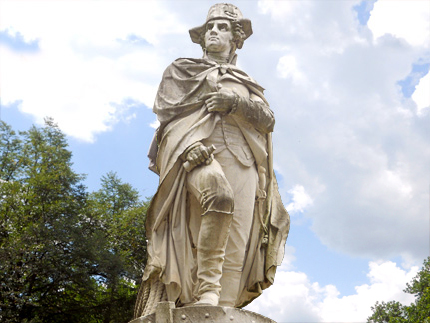
Washington Crossing The Delaware Statue
S. Montgomery St., near
Mill Hill Park
Map / Directions to the Washington Crossing the Delaware Statue
Map / Directions to all Trenton Revolutionary War Sites
The year of 1776 was a tumultuous one for the American cause in the Revolution. July 4 had seen the adoption of the Declaration of Independence, the permanent break with Britain. But on the military side, the war had gone very badly for Washington's army. Following disastrous battles in New York City, the American forces fled the island, which was then occupied by the British until the end of the War. Then Washington began a retreat from Fort Lee across New Jersey. By late December Washington and his army lay across the Delaware River in Pennsylvania. Washington came up with the daring plan to cross the Delaware River on Christmas night, and attack the Hessian soldiers at Trenton. (Hessians were German mercenary troops hired by the British to fight in the American Revolution.) The attack occurred early on the morning of December 26 and would become known as the First Battle of Trenton. (See next several entries.) [4]
This marble statue which commemorates Washington's Crossing of the Delaware was sculpted in Italy by Mahlon Dickerson Eyre. The statue was first displayed in 1876 in Philadelphia at the Centennial Exposition, the first World's Fair held in the United States. The statue was purchased by the city of Trenton in 1889, and it was erected in Trenton's Cadwalader Park in 1892. It was moved to this location in 1976. [5]



Abraham Hunt House Site
The Mary G. Roebling Building
20 W. State St.
Map / Directions to the Abraham Hunt House Site
Map / Directions to all Trenton Revolutionary War Sites
While Washington's army were preparing for their crossing of the Delaware, the Hessians stationed in Trenton had no idea that the following morning would bring a surprise attack, the First Battle of Trenton. The Hessian commander Colonel Johann Rall was entertained that Christmas evening at the house of Abraham Hunt. That house no longer stands, but a plaque on the N. Warren Street side of the Mary G. Roebling Building identifies this as the site of the house of Abraham Hunt. [6]




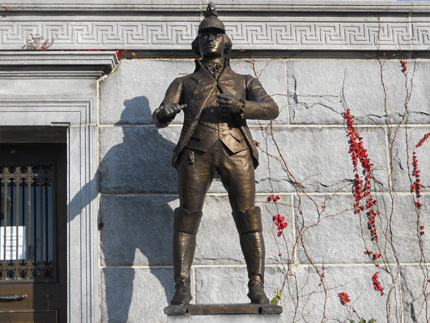


Trenton Battle Monument
N Warren St. and N. Broad St..
Map / Directions to the Trenton Battle Monument
Map / Directions to all Trenton Revolutionary War Sites
For information about visiting the Trenton Battle Monument, see the
Trenton Battle Monument Website
This monument commemorates the American victory at the first Battle of Trenton on December 26, 1776.
Hessian troops had occupied Trenton since December 14, 1776, while Washington's army encamped on the Pennsylvania side of the Delaware River, following their retreat across New Jersey beginning in Fort Lee on November 20. On the morning after the famous Christmas night crossing of the Delaware River by Washington and his troops, the Americans surprised the Hessian Troops stationed in Trenton.
Washington's plan was to arrive at Trenton before dawn, under the cover of darkness, so as to surprise the Hessians. Sunrise was at 7:20 a.m. that morning, but difficulties and delays in crossing the Delaware River and the nine-mile march through the snow to Trenton meant that the American army did not make their attack until around 8:00 a.m.. Fortunately for Washington's army, the surprise had been maintained, despite their late arrival in daylight. The Hessians were caught off guard by the attack and defeated decisively. (The often repeated legend that the Hessians were unprepared for the attack because of drunkenness the night before appears to be untrue.)
Most of the fighting was centered in the area running roughly from this monument south a half mile down, between Warren Street (then called King Street) and Broad Street (then called Queen Street). American artillery was positioned at the site where the monument now stands. As it was the high ground, it offered an excellent position for the cannons to fire down on the Hessian positions.
The American victory cost only several American casualties but inflicted substantial casualties to the Hessians: 22 dead, 83 wounded, and approximately 900 taken as prisoners of war. Among the Hessian casualties was their Commanding Officer, Colonel Johann Gottlieb Rall. After being mortally wounded, he was taken to the house of Stacy Potts on King Street (now Warren Street), which he had been using as his headquarters. He died there the next day. St Mary's Church now stands at the site of that house. (See Site of Colonel Rall Headquarters entry below.)
The victory at the first Battle of Trenton turned around the face of the war. After months of defeat and retreat for the American Army, this victory changed the morale of both the army and the country. It was followed up over the next ten days by additional victories at the Second Battle of Trenton (see entry below on this page) and the Battle of Princeton. [7]
The earliest intentions to build a monument to the Battle of Trenton date back to 1843. However, it took a half century for the monument to become a reality. Work finally began on the Trenton Battle Monument in 1891; it was unveiled on October 19, 1893, the 112th anniversary of the American Victory at the Battle of Yorktown. The dedication ceremony was a major event in Trenton, with speeches and a parade. In an article several days before the dedication ceremony, The New York Times indulged in a bit of hyperbole, stating, "The indications are that it will be the greatest day in the history of New Jersey." Local businesses and government buildings were decorated for the occasion, and a grandstand was erected around the monument to seat 3,000 people. Then-President Grover Cleveland (the only President to have been born in New Jersey) was expected to attend and speak, but he did not.
The monument, which stands 148 feet high, was designed by John H. Duncan, who was also the architect of Grant's Tomb in New York City. The monument contains three bronze sculptures by William O'Donovan. One is a statue of George Washington which stands atop the monument, looking and pointing out towards the site of his victory. The other two are the Continental soldiers who stand at the entrance. These were sculpted to represent two actual Revolutionary War soldiers. The one on the left who is holding the musket depicts Private John Russell of Captain John Selman's Company of the Fourteenth Regiment of the Continental Line organized in Massachusetts by Colonel John Glover. The statue on the right depicts Private Blair McClenachan of the Philadelphia Troop of Light Horse commanded by Captain Samuel Morris. [8]



St. Mary's Cathedral
Site of the Stacy Potts House (Colonel Rall's Headquarters)
151 North Warren St.
Map / Directions to St. Mary's Church
Map / Directions to all Trenton Revolutionary War Sites
Where the St. Mary's Cathedral now stands was once the home used as a headquarters of Hessian Commander Colonel, Johann Gottlieb Rall, at the time of the first Battle of Trenton, December 26, 1776. Rall had taken up his quarters here when the Hessians first occupied the city on December 14, 1776. The Colonel had apparently chosen a very nice house for his headquarters. The following description of the house was written in 1785 and makes it clear that the house was a quite impressive one for the time:
"The house is two stories high, spacious and elegant, having three rooms with fireplaces. besides a large dining room with two fireplaces on the lower floor. five rooms on the second floor, a large and convenient kitchen, a cellar under the whole, a pump at the door, a convenient lot with a stream of water running through it and an excellent garden - a stable sufficient to contain eight horses, with room for hay to keep them, may he had with it."
Fighting took place in the areas around the house during the Battle of Trenton. The house retained bullet marks from the fighting for as long as it existed. When the house was demolished in 1857, a window pane with a bullet hole from the battle was preserved; it is now displayed at the Old Barracks Museum. (See entry for Old Barrack Museum lower on this page.) [9]
Rall himself was mortally wounded in the Battle of Trenton. He died the following day, in the house that once stood here. He is buried in the Trenton First Presbyterian Church Cemetery. (See next entry.)
From November 30, 1784 to January 5, 1785 the Stacy Potts house was the official residence of Richard Henry Lee, President of the Continental Congress. [10] Lee, who was from Virginia, was in the city because from November 1 to December 24, 1784, the Congress was meeting at the French Arms Tavern in Trenton, which was located at what is now One State Street. (See the One State Street entry lower on this page.)



First Presbyterian Church Cemetery
114 East State St.
Map / Directions to the First Presbyterian Church
Map / Directions to all Trenton Revolutionary War Sites
Hessian Commander Johann Rall, who died of wounds suffered at the Battle of Trenton, is buried in this cemetery. So is Abraham Hunt, the man whose house Rall had been entertained in on the night before the Battle of Trenton. (See Abraham Hunt House Site entry above on this page.)
Reverend John Rosbrugh, who served as the chaplain of the 3rd Battalion of the County PA Militia, is also buried here. He was bayoneted to death by Hessian soldiers at the Second Battle of Trenton on January 2, 1777 (See the Second Battle of Trenton Site entry lower on this page).
Other American Revolutionary War veterans known to be buried here include:
James Francis Armstrong
John Beatty
Nicholas DeBelleville
Alexander Chambers
David R. Chambers
Robert Chambers
William Chambers
David Cowell
Ebenezer Cowell
John Cowell
James Ewing
Moore Furman
Smith Hill
Ellett Howell
William Roscoe
Isaac Smith
Elihu Spencer [11]


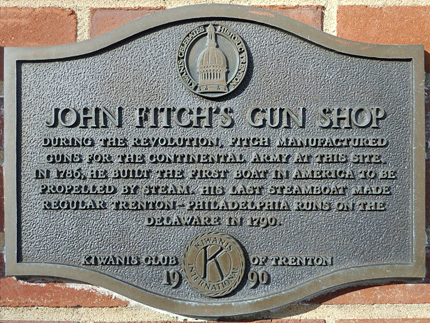


Site of John Fitch's Gun Shop
149 North Warren St.
Map / Directions to the John Fitch's Gun Shop
Map / Directions to all Trenton Revolutionary War Sites
Lt. John Fitch (1743 - 1798), who served as New Jersey's official state armorer during the Revolutionary War, operated his gun shop at this site. [12] When Hessian soldiers occupied Trenton in December 1776, Fitch and other known supporters of the American cause fled the city. He then served in the militia in Buck's County, Pennsylvania. In 1782, Fitch was held for at time as a prisoner of war by the British in Canada. John Fitch died by suicide sometime between June 25 and July 18, 1798. [13]
John Fitch is better known to history for his role in the development of steamboats. As the markers at this site note, Fitch's commercial steamboat ran between Trenton and Philadelphia in 1790, the first to operate on an advertised, regular schedule. A small monument dedicated specifically to John Fitch's accomplishments with steamboats can be found on Rt 29 South in Trenton, just before the intersection with South Warren Street. The monument, which overlooks the Delaware River, has a plaque which reads, "This commemorates the genius, patience and perseverance of Lieutenant John Fitch inventor of the first steamboat. It made successful trips between Philadelphia and Trenton in 1790 and docked near this site." [14]
A museum in Warminster, Pennsylvania is dedicated to Fitch's accomplishments in the field of steamboats. See the John Fitch Steamboat Museum's website for more information: www.fitch-steamboat-museum.org



St. Michael's Church
140 North Warren St.
Map / Directions to St. Michael's Church
Map / Directions to all Trenton Revolutionary War Sites
St. Michael's Church was built in 1703. It was located in the center of the fighting during the First Battle of Trenton. Prior to the Battle, Hessians had used the building as a barracks during their occupation of Trenton. It was later used by the Continental Army as a hospital.
The church had been touched by the politics of the war even before this. The church was then Anglican (Church of England), and a split in the congregation between those of loyalist and revolutionary sentiment led to a resolution by the vestry on July 7, 1776, to suspend church services for an indefinite period of time. The next day the Declaration of Independence was read publicly in Trenton from the court house steps. (See the Declaration of Independence Reading Mural entry above on this page.) [15]
David Brearley (Jun. 11, 1745 - Aug. 16, 1790) is buried in the cemetery. [16] He served as a Colonel in the New Jersey militia during the Revolutionary War, and later signed the United States Constitution for the State of New Jersey. There were four signers for New Jersey. The other three were:
~ William Livingston. (Built and lived in Liberty Hall in Union, also lived in the Livingston-Benedict house in Parsippany)
~ William Paterson (Paterson is named in his honor)
~ Jonathan Dayton (Lived at Boxwood Hall in Elizabeth, and buried at St. John's Episcopal Cemetery in Elizabeth)
There is a plaque on the front of the church marking the route General Washington took from Philadelphia to Cambridge, Massachusetts in 1775 to assume command of the Patriot Army. [17] On June 15, 1775, he had been appointed Commander in Chief of the Continental Army by Congress in Philadelphia. He passed through Trenton on June 23, and he would arrive in Cambridge to take command of the army on July 3. Another plaque marking Washington's route is located in New Brunswick.





The Old Barracks Museum
101 Barrack St.
Map / Directions to the Old Barracks Museum
Map / Directions to all Trenton Revolutionary War Sites
The Old Barracks served multiple functions at different times during the Revolutionary War: as a barracks, as an army hospital, and to hold prisoners of war. It is now a museum. See the Old Barracks Museum website for more information about visiting the museum, and about upcoming events. [18]



William Trent House Museum
15 Market St.
Map / Directions to the William Trent House
Map / Directions to all Trenton Revolutionary War Sites
For information about visiting the William Trent House Museum,
see www.williamtrenthouse.org
This house was built in 1719 by William Trent, from whom the town of Trenton takes its name. After Trent's death in 1724, the house passed through several owners. From 1742 - 1746, the house, then called "Bloomsbury Court," was used as the official residence of then-governor of New Jersey, Lewis Morris. Hessian soldiers occupied the house in December 1776, until the Hessian defeat at the first Battle of Trenton.
Dr. William Bryant, who was then the owner of the property, was a Loyalist, and he is believed to have warned Hessian Commander Johann Rall before the Battle of Trenton that "the rebels were going to cross the Delaware." Bryant was later expelled by the Americans for his Loyalist sympathies. The house was then acquired by Colonel John Cox, Deputy Quartermaster General of the Continental Army, who utilized the grounds as a supply depot for Washington's army. [19]
For more information about William Trent, the house, and museum, visit the museum website www.williamtrenthouse.org.





Friends (Quaker) Meeting House & Cemetery
143 East Hanover St.
Map / Directions to the Quaker Meeting House and Cemetery
Map / Directions to all Trenton Revolutionary War Sites
This Quaker Meeting House was built in 1739, with additions and alterations made in the late 1800's. Hessian soldiers occupied the meeting house prior to the first Battle of Trenton, and fighting took place around the building during the Battle. A week after, on January 2, 1777, at what would become the Second Battle of Trenton, the building was occupied by British Dragoons (Cavalrymen). The building was reportedly damaged by cannon balls during the Battles of Trenton, and the interior was damaged by the soldiers who occupied it. Due to the damage, the Meeting House was not used for some time afterward, and those belonging to the Meeting House met at a private home. [20]
Even before the Battles of Trenton, this Quaker Meeting House had been touched by the war. At some time in the first half of 1776, American troops stayed at the meeting house. During the first half of 1776, the meeting house was occupied by American troops en route from Pennsylvania to Amboy and Woodbridge. This apparently caused concern to Quakers who, because of their pacifistic beliefs, were opposed to any involvement in the war. [21] They had no way of knowing that their meeting house would soon be occupied by both Hessian and British troops, and would be in the middle of actual combat.
George Clymer (1739 - 1813), who signed both the Declaration of Independence and the United State Constitution for Pennsylvania, is buried in the cemetery. Clymer is one of only six men who signed both documents. (The other five were George Read, Roger Sherman, Benjamin Franklin, Robert Morris, and James Wilson.) Revolutionary War officers Major General Philemon Dickinson (1739 – 1809) and Colonel Lambert Cadwalader (1742 - 1823) are buried here as well. [22]

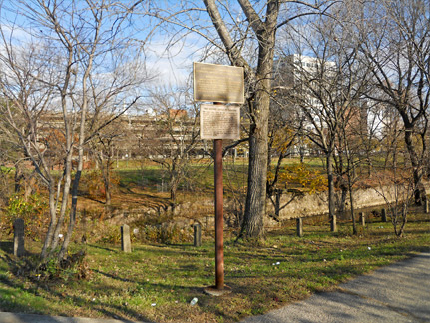



Second Battle of Trenton Site
S. Broad St. and Assunpink Dr.
Mill Hill Park
Map / Directions to the Second Battle of Trenton Site
Map / Directions to all Trenton Revolutionary War Sites
Following the First Battle of Trenton on December 26, Washington's army returned to their camp on the Pennsylvania side of the Delaware River. After some discussion concerning what to do next, the plan was made by the end of the following day to follow up their victory with another battle. They would return to Trenton (no longer occupied by Hessians, after their defeat on the 26th) and wait to be attacked by British and Hessian forces that would be converging on the town.
On December 29 and 30, Washington and his army again re-crossed the Delaware River into New Jersey to take up defensive positions in Trenton. This time they would be in the role of defending, rather than attacking, the city. However, unlike the Hessians at the First Battle of Trenton, the Americans would not be surprised by their attackers; they were waiting and planning for the attack that they knew would come.
On the 30th, Washington made his headquarters on Queen Street (now Broad), and troops took up defensive positions on the high ground south of Assunpink Creek. From here, they would be in position to defend the bridge over Assunpink Creek that the British would be attacking over. (Even though the area looks very different than it would have then and is filled with modern buildings, you can still get a sense of the elevations. Standing at the where Assunpink Creek crosses Broad Street facing south, the street clearly inclines. This shows the high ground the Americans would have held, firing down to the bridge.)
On the morning of January 2nd, British and Hessian troops under General Cornwallis marched to attack the American troops in Trenton from Princeton along the post road, which is now the path of Rt. 206. An important delay in their movements occurred because of skirmishes in Maidenhead (now Lawrenceville) on the post road near Five Mile Run and Shabakunk Creek. These skirmishes delayed the British attack until late in the afternoon. Because the Battle took place in early January, the sun would set early at 4:46 p.m. This meant there was little daylight left for the British to press their attack when they arrived in Trenton, which would greatly affect the outcome of the battle. [23]
The American troops successfully defended the bridge over the Assunpink Creek which stood near what is now the southwest corner of Mill Hill Park. A historic sign at the entrance to the park describes the events: "On this site, late in the afternoon of January 2, 1777, General Washington's 'Little Band' of determined men and boys won the second Battle of Trenton. Having amassed a great concentration of artillery and small-arms power, the Americans withstood three powerful charges by the enemy and exacted a heavy toll in killed and wounded. This stand enabled the Americans to outflank the enemy during the night and march on to another victory at Princeton, thus completing the ten days that kept a dying Revolution alive." [24] Another sign, on the other side of the park, gives information about the history of the Mill Hill Historic District, including the Second Battle of Trenton.
By evening, the American troops had held their position, but they faced difficult choices as to their next move. The following day, the British would have a full day of daylight to attack, and the British troops now greatly unnumbered the Americans. Washington called a council of War at the house of Alexander Douglass, which had been used as the headquarters of General Arthur St. Clair during the battle. At this council of war, the bold plan to attack Princeton was decided upon. (See next entry.)

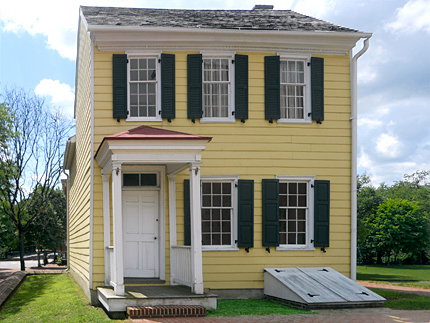

Alexander Douglass House
165 East Front St.
Map / Directions to the Alexander Douglass House
Map / Directions to all Trenton Revolutionary War Sites
Currently closed during restoration
In the evening after the fighting in the Second Battle of Trenton, General Washington held an important council of war at the Alexander Douglass House. (At that time the house stood on what is now South Broad Street in Trenton.) The house had served as the quarters of General Arthur St. Clair during the Battle. After a day of fighting, the British and American troops were on opposite sides of the Assunpink Creek. Washington called a council of war here to consider a plan of action for the following day. The officers In attendance, including Generals Arthur St. Clair, Nathanael Greene, James Sullivan, Hugh Mercer, and Henry Knox, discussed the difficult situation they were in. To continue the battle the next morning would likely lead to a British victory; to retreat to their position down river be difficult. Revolutionary War officer James Wilkinson later wrote of this council in his memoirs: [25]
"General Washington encompassed as he was by dangers, had but a brief statement to submit to his council; the situation of the two armies were known to all; a battle was certain, if he kept his ground until the morning, and in case of an action a defeat was to be apprehended; a retreat by the only route thought of, down the river would be difficult and precarious; the loss of the corps he commanded might be fatal to the country: under these circumstances he asked advice - opinions were various - some inclined to retreat, others to hazard all on a general engagement, and it has been suggested to me, that the commander in chief, yielding to his natural propensities, favoured the latter proposition."
After some discussion of these two difficult options, a third option arose. Instead of a direct engagement with the British troops, or a retreat, the American army could stage an attack on the British rear at Princeton, and then proceed to an attack on New Brunswick. After some discussion, this plan was approved. According to General St. Clair, "General Washington highly approved it, nor was there one dissenting voice in the council." [26]
The army proceeded to advance on Princeton in the evening and to attack at Princeton the following morning, January 3, 1777. Although victorious at the Battle of Princeton, the second part of the plan, an attack on New Brunswick, was not made. Instead the army headed from Princeton to Morristown, where they would stay in winter quarters from January 6 - May 28 .
The Alexander Douglass house was built circa 1760, and was originally a one-room, two-story "shanty." Douglass purchased the house in 1769, and around 1800, he added the two-story front structure. The Douglass family retained ownership of the house until 1852. At the time of Washington's council of war, the house stood on South Broad Street. It has since been moved several times. The house was first moved in 1876 to Center Street. In 1924 the city of Trenton acquired the house and moved it to Mahlon Stacy Park. It was moved to its current location in 1972. (See next entry below for the original site of the Alexander Douglass House.) [27]



Original site of the Alexander Douglass House
Lutheran Church
189 S. Broad St.
Map / Directions to Original Alexander Douglass site
Map / Directions to all Trenton Revolutionary War Sites


12 Obelisks Marking Washington's Route from Trenton to Princeton
Map of Route of all 12 obelisks, from Trenton to Princeton
These twelve obelisks mark the route taken by General Washington and his troops after the Second Battle of Trenton to the Battle of Princeton.
Although these markers work their way through Hamilton, Mercerville, Lawrence and into Princeton, they are all listed and pictured here on the Trenton page for the sake of convenience.
The obelisks were erected by the New Jersey Sons of the Revolution in March 1914. The actual construction and installation of the obelisks was done by the John L. & William Passmore Meeker company of Newark. The obelisks were most likely placed at their twelve locations sometime in April or May 1914. [28] The Meeker company ran a steam-powered workshop on Market Street in Newark that made marble and granite monuments. They opened in 1860 [29] and were successful and noted enough to have received a commission from the state of New Jersey to create monuments to New Jersey troops at Maryland's Antietam Battlefield National Park in 1902 - 1903. [30]
A March 8, 1914 article in the Trenton newspaper the Sunday Times-Advertiser reported that these obelisks were about to be built. The article described in great detail the construction of the obelisks, making a great point of how sturdily they were to be constructed: [31]
"The obelisks are to be made of the best Quincy granite and will be rock faced on all four sides. They will be eight feet tall, but two feet of this length will be set in the ground, imbedded in concrete, to make their removal all but impossible. They will be one foot six inches on each side. Bronze tablets, one foot wide by sixteen inches tall, will be set in the front face of each obelisk at little above the middle of the length. They will be recessed in the rock and fastened with the greatest firmness and by means of bolts that will be invisible from the surface of the tablets. The bolts will, morever [sic], be located at points in the tablet that would scarcely be suspected."

First Obelisk - Hamilton Avenue at South Broad Street.
In front of the Sun Center National Bank

Second Obelisk - Hamilton Avenue at Chestnut Avenue.
In front of Bank of America

Third Obelisk - 1800 Hamilton Avenue.
Inside Greenwood Cemetery.

Fourth Obelisk - 1070 Klockner Road.
In Front of the Health Careers Center.

Fifth Obelisk - 77 Christine Avenue / Hamilton, NJ
In front of the VFW.

Sixth Obelisk - Quakerbridge Road near Clearview Ave / Hamilton, NJ
In Median

Seventh Obelisk - 133 Youngs Road / Mercerville, NJ
In Front of Hamilton Fitness Center
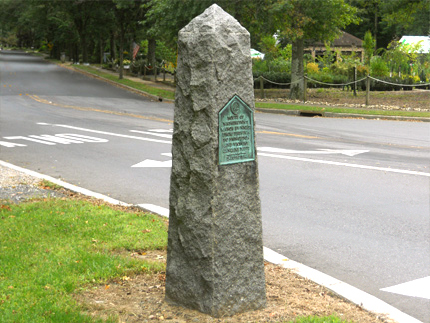
Eighth Obelisk - Quakerbridge Road & Hughes Drive / Hamilton, NJ
At the corner

Ninth Obelisk - Quakerbridge Rd & Nassau Park Blvd / Lawrence, NJ
- In Median on Quakerbridge - Partly hidden in the trees

Tenth Obelisk - Quaker Road / Princeton NJ
D & R Canal State Park Trail, right by the parking lot.
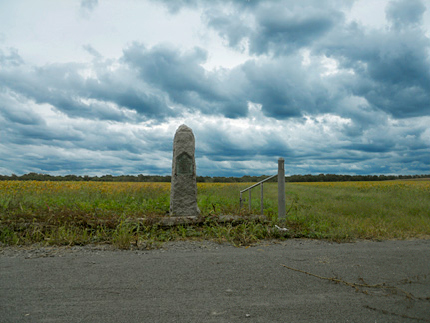
Eleventh Obelisk - In a field next to Quaker Road / Princeton, NJ

Twelfth Obelisk - Behind Clark House in Princeton Battlefield State Park
- In the woods behind the house, on the walking path.

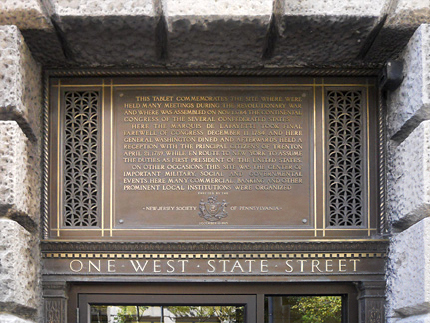



1 West State Street
Site of the Thirteen Stars Tavern / French Arms Tavern / City Tavern
1 W. State St.
Map / Directions to 1 West State Street
Map / Directions to all Trenton Revolutionary War Sites
This was once the site of a tavern that was the site of important events in the1780's. Plaques on the building commemorate several Revolutionary War era events that occurred at this site: [32]
• Congress, under the Articles of Confederation, met here from November 1, to December 24, 1784
• General Marquis de Lafayette made his final farewell to Congress during this session, on December 11, 1784
• New Jersey ratified the United States Constitution on December 18, 1787
• On April 21, 1789, a reception was held here for Washington, following his greeting at the Triumphal Arch, when he was en route to the his inauguration as President in New York City .(See the following four entries for more information about this event.)
A set of doors on the building features bas reliefs of George Washington, Marquis de Lafayette, Benjamin Franklin, and Alexander Hamilton.
The tavern itself went through a series of name changes during the period. In the Trenton Historical Society book, A History of Trenton, 1679-1929: Two Hundred and Fifty Years of a Notable Town with Links in Four Centuries, Mary J. Messler, explained the name changes: "This famous tavern stood on the southwest corner of King (now Warren) and Second (now State) Streets. From April 1, 1780, to February, 1781, it was called the Thirteen Stars, but when John Cape became proprietor in 1781 he changed the name to the French Arms, which name was retained until January 4, 1785, when the tavern was leased to Francis Witt. He had been the proprietor of a tavern on North King Street, called the Blazing Star, and merely transferred the sign to his new establishment. The name was again changed, this time to the City Tavern, in April 1789, when Henry Drake became its proprietor." [33]



Trenton Ferry Site
Bloomsbury St. near Bridge St. Overpass
Map / Directions to Trenton Ferry site
Map / Directions to all Trenton Revolutionary War Sites
When George Washington was elected the first president of the United States, the national capitol was New York City. During April of 1789, Washington traveled from his home in Virginia to New York City, where he would be inaugurated President on April 30. This historic sign marks the site of the Trenton Ferry, where on April 21, 1789, Washington entered Trenton from Pennsylvania on his way to New York. He had received a reception in Philadelphia the day before. [34]
As the sign notes, a Trenton reception was held for Washington in City Tavern, which was located at what is now One West State Street. [35] (See the One West State Street Building entry above.)



George Washington Triumphal Arch Site
South Broad St. and Lafayette St.
Map / Directions to the George Washington Triumphal Arch Site
Map / Directions to all Trenton Revolutionary War Sites
After entering Trenton on April 21, 1789, en route to being inaugurated the new nation's first President, George Washington passed through a triumphal arch at this spot, which is now marked by the small plaque on the brick wall. [36] This was the same bridge location where Washington's army had held off the British attack during the Second Battle of Trenton.
John Marshall wrote the following vivid description of the event and the arch: [37]
"On the bridge over the creek which passes through the town, was erected a triumphal arch highly ornamented with laurels and flowers: and supported by thirteen pillars, each entwined with wreaths of evergreen. On the front arch was inscribed in large gilt letters, THE DEFENDER OF THE MOTHERS WILL BE THE PROTECTOR OF THE DAUGHTERS.
"On the centre of the arch above the inscription, was a dome or cupola of flowers and evergreens, encircling the dates of two memorable events which were peculiarly interesting to New Jersey. The first was the battle of Trenton, and the second the bold and judicious stand made by the American troops at the same creek, by which the progress of the British army was arrested on the evening preceding the battle of Princeton.
"At this place, he was met by a party of matrons leading their daughters dressed in white, who carried baskets of flowers in their hands, and sang, with exquisite sweetness, an ode of two stanzas composed for the occasion."
The song they sang not only honored Washington; it also made the contrast between Washington's circumstances at this spot in 1776-1777, and the the joy of the current moment as he went to assume the role of first president of the United States, tying together these two great New Jersey moments.
These are the words of the song they sang: [38]
Welcome, mighty Chief, once more!
Welcome to this grateful shore;
Now no more mercenary foe
Aims again the fatal blow;
Aims at thee, the fatal blow.Virgins fair and Matrons grave,
These thy conquering arm did save,
Build for thee triumphal bowers.
Strew, ye fair, his way with flowers.
Strew your hero's way with flowers."
Before leaving Trenton, Washington wrote the following note "To the ladies of Trenton." He himself noted the contrast between his experience here at the time of the Battles of Trenton, and as he was greeted as President-elect at this triumphant arch. He appeared to be genuinely touched by the occasion. The note read as follows: [39] (To avoid confusion, I would like to point out that this is a letter written by Washington - he is referring to himself in the third person throughout the note.)
"General Washington cannot leave this place without expressing his acknowledgments to the matrons and young ladies who received him in so novel and graceful a manner at the triumphal arch in Trenton, for the exquisite sensations he experienced in that affecting moment.
"The astonishing contrast between his former and actual situation at the same spot; the elegant taste with which it was adorned for the present occasion; and the innocent appearance of the white robed choir, who met him with the gratulatory song, have made such impressions on his remembrance, as, he assures them, will never be effaced."
A section of the triumphal arch is displayed in the Trentoniana room of the Trenton Public Library. (See next entry.)
A magnificent mural of Washington passing through the triumphal arch, painted by N.C. Wyeth, hangs inside Thomas Edison State College on West State Street. (See second entry following.)
After leaving Trenton, Washington continued on across New Jersey. He was greeted with receptions along the way at Woodbridge, Rahway, and Elizabeth.

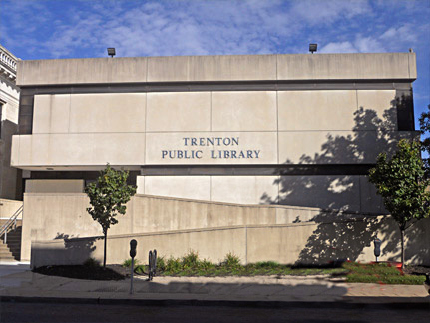


Trenton Public Library
120 Academy St.
Map / Directions to the Trenton Public Library
Map / Directions to all Trenton Revolutionary War Sites
A section of the Washington Triumphal Arch described in the above entry is displayed in the library's Trentoniana room. The Trentoniana room is devoted to local Trenton history, with large local and genealogical collections.


Thomas Edison State College
Displaying George Washington Mural by N.C. Wyeth
101 W. State St.
Map / Directions to the Thomas Edison State College Office
Map / Directions to all Trenton Revolutionary War Sites
This 17 ft. by 12 ft. mural of George Washington passing through the triumphal arch currently hangs inside the Thomas Edison State College. The painting's official title is "Reception to Washington on April 21, 1789, at Trenton on his way to New York to Assume the Duties of the Presidency of the United States."
Painted in 1930 by N.C. Wyeth (1882-1945), the mural was commissioned by the First Mechanics Bank for their building at 1 West State Street, which later became Wells Fargo. (See next entry about 1 West State Street.) The mural was displayed there until 2014, when Wells Fargo moved into a smaller building on East State Street. At that time, they loaned the mural to the Thomas Edison State College, where it is now on display. [40]
If you are in this area, I highly recommend going into the building to see the mural. The photo cannot really do the actual mural justice. (Note that the photo at the right was taken when the painting was on display at the Wells Fargo branch.)


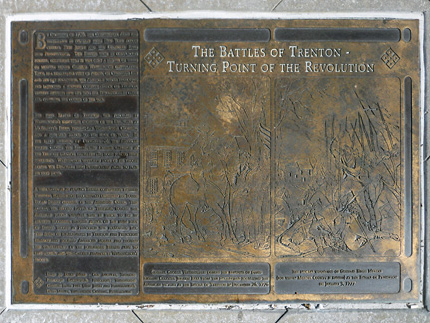


South River Walk Park
Park your car in Waterfront Park, and then walk up the stairs to South River Walk Park
Map / Directions to South River Walk Park
Map / Directions to all Trenton Revolutionary War Sites
South River Walk Park is an esplanade along the Delaware River. It features a series of historical plaques set into pavement that tell the history of Trenton from the 1600's to the present, including a number of plaques related to Revolutionary War era events.

1. ^ Harry J. Podmore, Revised and Edited by Mary J. Messler, Trenton Old and New (Trenton: Published under the auspices of the Trenton Tercentenary Commission, Printed by MacCrellish & Quigley Company, 1964)
Available to be read on the Trenton Historical Society website here
The book states that the Court House "stood on the east side of Warren Street, just south of State Street," which would have placed it on the other side of Warren Street from where the mural is.An article about the Declaration of Independence's being read in Trenton on July 8, 1776 appeared in several newspapers in late July 1776, including:
• Maryland Gazette, July 25, 1776 - A scan of the newspaper is available on the Maryland State Archives website here
• Virginia Gazette July 26, 1776 - A scan of the newspaper is available on the Colonial Williamsburg website here2. ^ A 2006 News 12 New Jersey story showed Illia Barger talking about including local residents in the mural. The video can be seen on the Videos page of her website here
3. ^ Diana Cercone, "Illia Barger Specializes in Creativity," Bucks County Herald [Bucks County, Pennsylvania], December 8, 2011, Page C12.
4. ^ For a detailed account of the crossing of the Delaware, see:
David Hackett Fischer, Washington's Crossing (New York: Oxford University Press, 2004)5. ^ Information about the history of this statue was drawn from:
• Nadine Sergejeff, Damon Tvaryanas, Ian Burrow, Richard Hunter / Prepared for The Old Mill Society The Assunpink Creek In Mill Hill A History And Consideration Of Historic Interpretive Opportunities (2002) Chapter 3: "Present-Day Land Use"
Available to be read on the Trenton Historical Society website here• Plaques on the pedestal of the statue
The Centennial Exhibition Digital Collection, on the website of The Free Library of Philadelphia, contains a great deal of information about, and photographs of, The Centennial Exposition. Those interested in more information about the Centennial Exposition are recommended to the website: http://libwww.library.phila.gov/CenCol/
One of the photos in the collection shows this statue where it stood at the Centennial Exposition. The statue is visible on the right side of the photo. It looks a bit small in the photo, but if you look closely, you can tell it is this statue. This photo can be found here at The Centennial Exhibition Digital Collection.6. ^ Sign erected by the Trenton High School class of 1904 on February 22, 1902.
7. ^ David Hackett Fischer, Washington's Crossing (New York: Oxford University Press, 2004) p. 234 - 262
8. ^ Information about the Battle Monument's history, architecture, sculpture, and dedication ceremony were drawn from three contemporary sources:
• Souvenir, Trenton Battle Monument Association (Philadelphia: Oponlinger & Browne Publishing Co., 1893)
This booklet, which was published as a souvenir program for the dedication ceremony, is available to be read at Google Books here• Daily True American (Trenton), October 19, 1893
A scan is available at the blog of Tom Glover, Hamilton Township Historian at the Hamilton Township Public Library Local History Collection here. (Digitized by Tom Glover - Hamilton Township Public Library - Local History Collection)• "Battle Monument Unveiling - Preparations Nearly Completed for the Ceremony" The New York Times October 15, 1893
Available at The New York Times website here◆ Regarding the identification of soldiers represented by the statues, the Souvenir, Trenton Battle Monument Association booklet contained the following detailed information on page 45:
"At one side of the doorway of the monument appropriately guarding the entrance, stands a bronze statue of Private John Russell, of Captain John Selman's Company of the Regiment of the Continental Line, organized in Massachusetts by Colonel John Glover. This regiment distinguished itself aiding the American Army to escape over the East River to York City after the battle of Long Island, and again in the historic crossing of the Delaware River on the night before battle of Trenton. This soldier's likeness is taken from a medallion executed in Paris, France, after the war, when he was in that city, having crossed the ocean as captain of a sloop in merchant service. He is represented in the uniform of this splendid regiment of Marblehead Fishermen, as worn in December, 1776. It is placed on the monument by the patriotic of the Commonwealth of Massachusetts.
"On the other side of the doorway is the statue modelled after a likeness of Private Blair McClenachan of the Philadelphia Troop of Light Horse, which troop took part in the battle of Trenton. The Troop was commanded by Captain Samuel Morris and after its service in the winter campaign of 1776-77 the Commander in Chief wrote them the following letter:
'The Philadelphia Troop of Light Horse under the command of Captain Morris, having performed their Tour of duty are discharged for the present.
'I take this opportunity of returning my most sincere thanks to the Captain and to the Gentlemen who compose the Troop for the many essential Services which they have rendered to their Country, and to me personally during the Course of this severe Campaign. Tho' composed of Gentlemen of Fortune, they have shewn a noble Example of discipline and subordination, and in several Actions have shewn a Spirit of Bravery which will ever do Honor to them and will ever be gratefully remembered by me.
Given at Head Quarters at
Morris Town this 23d Jan'y 1777
Go WASHINGTON'"It [the statue] is the gift of the Troop now known as the First Troop Philadelphia City Cavalry, an organization which has existed since the Revolutionary period."
9. ^ Details about the history of the house, the damage it suffered in the fighting, and the year it was demolished, were drawn from a June 12, 1857 State Gazette article about the house being demolished:
"Revolutionary Relic - Workmen are now engaged in demolishing the house in Warren Street, opposite Perry, long known as the City Hotel. This house is probably over a hundred years old, and at the time of the Revolution was one of the largest and most elegant houses in the town. It was occupied by Colonel Rall, the commander of the Hessians, and was his headquarters at the time of the Battle of Trenton. It bears many marks of that combat, in the shape of bullet holes and marks in the weatherboards, and tradition relates that a Hessian officer was shot through one of its windows while shaving himself. The window with the bullet hole through the glass is preserved by Dr. Quick, the owner of the house."
(The "tradition" about the officer shot while shaving is most likely a fanciful story. More likely the bullet hole was simply the result of bullets flying in many directions during the fighting, and one hitting the window.)The quoted 1785 description of the Stacy Potts house ("The house is two stories high, spacious and elegant...) originally appeared in an advertisement to rent the house in the State Gazette on January 10, 1785. That advertisement was itself reprinted to accompany their June 12, 1857 article about the demolishing.
The 1785 and 1857 State Gazette material is quoted from:
Harry J. Podmore, Revised and Edited by Mary J. Messler, Trenton Old and New (Trenton: Published under the auspices of the Trenton Tercentenary Commission, Printed by MacCrellish & Quigley Company, 1964) Available to be read on the Trenton Historical Society website here10. ^ Plaque on the church, placed by the New Jersey Society of Sons of the Revolution on February 22, 1919.
11. ^ Names of Americans from a plaque on the front of the church, erected by General David Forman Chapter of the Daughters of the American Revolution, 1933
• Johann Rall's original gravestone is no longer in the cemetery. However, his name appears on a plaque in the cemetery listing "Names of persons interred in the west yard of the church whose markers have been destroyed by time." The plaque was erected in 1933 by the General David Forman Chapter, Daughters of the American Revolution.
Another modern plaque in the cemetery states that it is "Erected to the memory of Colonel Johann Gottleib Rall died 26 December 1776."
• A stone to Reverend John Rosbrugh in the cemetery was erected by the Presbytery of New Brunswick in 1917.12. ^ There are two markers at the site identifying this as the location of Fitch's shop. One was a placed by the city of Trenton. The other by the Kiwanis Club of Trenton in 1990.
• The Trenton Historical Society book, A History of Trenton, 1679-1929: Two Hundred and Fifty Years of a Notable Town with Links in Four Centuries (Princeton, Princeton University Press, 1929), supports this as the location of the gun shop. In Chapter 2, Hamilton Schuyler stated that "John Fitch, then a gunsmith, had a shop on King Street." In the same chapter, she explains that the King Street of that time is now Warren Street.
This book is available to be read on the Trenton Historical Society's website here13. ^ Biographical information about Lt. John Finch was drawn from:
Thompson Wescott, The Life of John Fitch - The Inventor of the Steamboat (Philadelphia: J.P. Lippincott & Co. 1857)
Available at the Internet Archive here
• The City of Trenton sign here states that the shop was "damaged by the Hessians in 1776." The Trenton Historical Society book, A History of Trenton, 1679-1929: Two Hundred and Fifty Years of a Notable Town with Links in Four Centuries, (see above footnote) states, "The shop was burned by the British in 1776." The Wescott biography does not mention the fate of the shop after Fitch left the city.Because of the confusion (Hessians or British; damaged or burned), I have chosen to leave mention of this out of the main entry. However, I will state here that it makes sense that the gun shop would have been targeted in some way by the opposing forces after Fitch fled Trenton.
14. ^ Monument bears a City of Trenton New Jersey seal, and states that is was "Erected by the commissioners of Trenton November 30, 1921" and "Relocated to this site Spring, 1998."
15. ^ Church History page of St. Michael's Church of Trenton website
16. ^ Grave stone in the cemetery
17. ^ Erected by the New Jersey Society Sons of the American Revolution, June 23, 1914
18. ^The Old Barracks Museum website
19. ^ Information about the history of the William Trent House was drawn from the William Trent House Museum website
• The quote about Dr. Byrant's warning that "the rebels were going to cross the Delaware" appears in:
David Hackett Fischer, Washington's Crossing (New York, Oxford University Press, 2004) p. 204
Fischer quotes this plus another quote of warning that was not made by Dr. Bryant; his source notes attribute these quotes to:
Testimony of Lt. Jacob Bill, 24 April 1778; Lt. George Zoll, 27 April 1778; Lt. Christian von Hoben, 7 May 1778; Ensign Friedrich Henndorf, 11 May 1778, Hessian Court of Inquiry, Lidgerwood Transcripts, ML 87, 193, 223, 25620. ^National Register of Historic Places Registration Form submitted for the Trenton Friends Meeting House to the United States Department of the Interior, National Park Service, received August 13, 2007. Prepared by Sheila Koehler of Westfield Architects & Preservation Consultants.
Available to be read hereThis document provides details about the church's construction and the alterations / additions made in the 1800's.
21. ^ Chesterfield Monthly Meeting, Men's Minutes, 1774-1786, contains the following in the entry for August 1, 1776:
"The Meeting Mouse in Trenton belonging to friends having been used by the Convention or Congress of this Province to meet in and also the Soldiers in passing through from Pennsylvania to Amboy and Woodbridge have been quartered therein. Therefore this meeting appoints Isaiah Robins, Amos Middleton, John Bullock, Benjamin Clarke and Benjamin Linton to inspect into the case and see how far our Antient [sic] Testimony against Wars hath been maintained and supported and report to next Meeting."
Available to be read at Triptych | the Tri-College Digital Library (a digital initiative of the Bryn Mawr, Haverford, and Swarthmore College Libraries) here (Click on file #538 to locate the specific page this appears on.)22. ^ Gravestone and markers at the cemetery.
23. ^David Hackett Fischer, Washington's Crossing (New York: Oxford University Press, 2004) p. 263 -307
24. ^ Historic sign
25. ^General James Wilkinson, Memoirs of my Own Times, Volume 1 (Philadelphia: Abraham Small, 1816) p.140
Available to be read at the Internet Archive hereNote that Wilkinson was not present at the council. At the time he was serving as an aide to General St. Clair. Wilkinson states, immediately before the text quoted, that "It may be proper to remark, that what follows with respect to the council of war, I received from General St. Clair, to whose person I was attached."
Also, Wilkinson mistakenly recalls that the council may have occurred at the home of Mary Dagworthy, rather than the Douglass House. But by his phrasing, he himself makes it clear that he was not certain of the location. He wrote that the council occurred "if memory serves me, in the house of a Miss Dagworthy" (emphasis added).26. ^ William Henry Smith, The St. Clair Papers: The Life and Public Services of Arthur St. Clair (Cincinnati: Robert Clarke & Co. 1882) p.36
Available to be read at Google Books here27. ^ City of Trenton sign in front of the Alexander Douglass house
28. ^ "To Mark Washington's Route From Trenton to Princeton," Sunday Times-Advertiser [Trenton, NJ] March 8, 1914
29. ^ Richard Francis Veit, Mark Nonestied, New Jersey Cemeteries and Tombstones: History in the Landscape (New Brunswick, Rutgers University Press, 2008) p. 145
Available to be read at Google Books here30. ^ Report of the Joint Committee on Treasurer's Accounts and of the State Treasurer to the Legislature of New Jersey / For the Fiscal Year Ending October 31st 1903 (Sinnickson Chew & Sons Company 1903) p. 235-236 here
31. ^ "To Mark Washington's Route From Trenton to Princeton," Sunday Times-Advertiser [Trenton, NJ] March 8, 1914
32. ^ The plaque over the entrance, placed by the New Jersey Society of Pennsylvania on December 11, 1915, mentions Congress meeting here, the Lafayette farewell, and the George Washington reception.
• This plaque only gives the opening date of the Congress session. The opening and closing dates of this session are given on the website of the United States Senate.
• For more source information about Washington's reception at City Tavern, see Source Note 28 above.Another plaque on the building identifies this as the site of the New Jersey ratification of the United States Constitution. This sign has the Great Seal of the United States, but no further credit for who posted the sign. It does note that "the one hundred and fiftieth anniversary of the ratification of the Constitution was here celebrated on the 11th day of November 1937."
33. ^ Trenton Historical Society, A History of Trenton, 1679-1929: Two Hundred and Fifty Years of a Notable Town with Links in Four Centuries (Princeton, Princeton University Press, 1929) Chapter IV (Chapter IV written by Mary J. Messler)
Available to be read online here34. ^ John Marshall, The Life of George Washington, Vol. 4 (of 5) (Project Gutenberg EBook Edition: Release Date: June 15, 2006 [EBook #18594]) Chapter 4
Available at the Project Gutenberg website here
• John Marshall, who was the fourth Chief Justice of the Supreme Court, famous for the Marbury vs. Madison decision, was a contemporary and admirer of Washington. His five volume biography of Washington was originally published between 1804 - 1807, within a decade of Washington's death (December 14, 1799).
35. ^ • The New Jersey State Historic sign at the Ferry Site states, "Reception held in City Tavern."
• The Trenton Historical Society book, A History of Trenton, 1679-1929: Two Hundred and Fifty Years of a Notable Town with Links in Four Centuries, contains the following information about the history of City Tavern and its location in Chapter IV (emphasis on the City Tavern name added):
"This famous tavern stood on the southwest corner of King (now Warren) and Second (now State) Streets. From April 1, 1780, to February, 1781, it was called the Thirteen Stars, but when John Cape became proprietor in 1781 he changed the name to the French Arms, which name was retained until January 4, 1785, when the tavern was leased to Francis Witt. He had been the proprietor of a tavern on North King Street, called the Blazing Star, and merely transferred the sign to his new establishment. The name was again changed, this time to the City Tavern, in April 1789, when Henry Drake became its proprietor."
(From Chapter IV, Written by Mary J. Messler / Book is available to be read on the Trenton Historical Society's website here )This information places the site of City Tavern at the corner of what is now Warren and State Streets. This is now the One West State Street building.
• The One West State Street building itself has a sign over the door, placed by the New Jersey Society of Pennsylvania on December 11, 1915, telling of the history of this location, including, "And here General Washington dined and afterwards held a reception with the principal citizens of Trenton April 21, 1789, while en route to New York to assume the duties as first President of the United States."
A photo of this sign can be seen in the One West State Street entry above
36. ^ The plaque at this site, which reads, "At the bridge over the Assunpink Creek on April 21, 1789, the citizens of Trenton honored George Washington as he passed through a triumphal arch on his way to New York City to be inaugurated President of the United States," was placed by by the Kiwanis Club of Trenton in 1989.
37. ^ John Marshall, The Life of George Washington, Vol. 4 (of 5) (Project Gutenberg EBook Edition: Release Date: June 15, 2006 [EBook #18594]) Chapter 4
Available at the Project Gutenberg website here38. ^ George Washington; Edited by Jared Sparks, The Writings of George Washington Volume 12 (Boston: American Stationers' Company, John B. Russel 1837) p. 150
Available to be read at Google Books here39. ^ George Washington; Edited by Jared Sparks, The Writings of George Washington Volume 12 (Boston: American Stationers' Company, John B. Russel 1837) p. 150
Available to be read at Google Books here40. ^ Carlos Avila, "Bank Lends Famous Washington Mural to Thomas Edison State College," The Trentonian News [Trenton], April 21, 2014
Available to be read online here